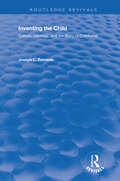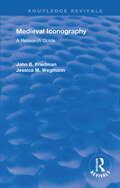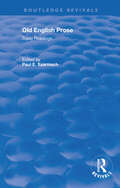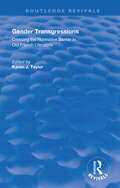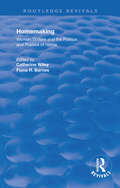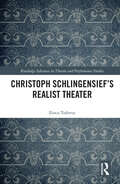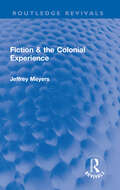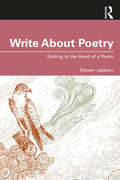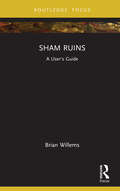- Table View
- List View
Inventing the Child: Culture, Ideology and the Story of the Child
by Joseph L. ZornadoThis book traces the historical roots of Western culture's stories of childhood in which the child is subjugated to the adult. Going back 400 years, it looks again at Hamlet, fairy tales of the Brothers Grimm, and Walt Disney cartoons. Inventing the Child is a highly entertaining, humorous, and at times acerbic account of what it means to be a child (and a parent) in America at the dawn of the new millennium. John Zornado explores the history and development of the concept of childhood, starting with the works of Calvin, Freud, and Rousseau and culminating with the modern "consumer" childhood of Dr. Spock and television. The volume discusses major media depictions of childhood and examines the ways in which parents use different forms of media to swaddle, educate, and entertain their children. Zornado argues that the stories we tell our children contain the ideologies of the dominant culture--which, more often than not, promote "happiness" at all costs, materialism as the way to happiness, and above all, obedience to the dominant order.
Medieval Iconography: A Research Guide
by John B. Friedman Jessica M. WegmannFirst published in 1998, the present volume aims to help the researcher locate visual motifs, whether in medieval art or in literature, and to understand how they function in yet other medieval literary or artistic works.
Old English Prose: Basic Readings
by Paul E. SzarmachFirst published in 2001. With the decline of formalism and its predilection for Old English poetry, Old English prose is leaving the periphery and moving into the center of literary and cultural discussion. The extensive corpus of Old English prose lends many texts of various kinds to the current debates over literary theory and its multiple manifestations. The purpose of this collection is to assist the growing interest in Old English prose by providing essays that help establish the foundations for considered study and offer models and examples of special studies. Both retrospective and current in its examples, this collection can serve as a "first book" for an introduction to study, particularly suitable for courses that seek to entertain such issues as authorship, texts and textuality, source criticism, genre, and forms of historical criticism as a significant part of a broad, cultural teaching (and research) plan.
Susan Sontag: An Annotated Bibliography 1948-1992 (Modern Critics And Critical Studies)
by LELAND POAGUE; KATHY A. PARSONSSusan Sontag: An Annotated Bibliography catalogues the works of one of America's most prolific and important 20th century authors. Known for her philosophical writings on American culture, topics left untouched by Sontag's writings are few and far between. This volume is an exhaustive collection that includes her novels, essays, reviews, films and interviews. Each entry is accompanied by an annotated bibliography.
The Legend of Guy of Warwick (Garland Studies In Medieval Literature Ser. #14)
by Velma Bourgeois RichmondFirst published in 1996. This lavishly illustrated study is a comprehensive literary and social history which offers a record of changing genres, manuscript/book production, and cultural, political, and religious emphases by examining one of the most long lived popular legends in England. Guy of Warwick became part of history when he was named in chronicles and heraldic rolls. The power of the Earls of Warwick, especially Richard de Beauchamp, inspired the spread of the legend, but Guy's highest fame came in the Renaissance as one of the Nine Worthies. Widely praised in texts and allusions, Guy's feats were sung in ballads and celebrated on the stage in England and France.The first Anglo-Norman romance of Gui de Warewic, a Saxon hero of the tenth century was written in the early 13th century; the latest retellings of the legend are contemporary. Examples of Guy's legend can be found in two English translations that survived the Middle Ages, a new French prose romance, a didactic tale in the Gesta Romanorum, and late medieval versions in Celtic, German, and Catalan, as well as English. Guy remained a favorite Edwardian children's story and was featured in the Warwick Pageant, an historical extravaganza of 1906. The patriotism of World War II sparked a resurgence of interest that produced several new versions, mostly folkloric.
Anglo-Saxon History: Basic Readings
by David A. E. PelteretFirst published in 2000, Basic Readings in Anglo-Saxon England (BRASE) is a series of volumes that collect classic, exemplary, or ground-breaking essays in the fields of Anglo-Saxon studies generally written in the 1960s or later, or commissioned by a volume editor to fulfill the purpose of the given volume. This, the sixth volume in the series, is the first devoted to history and the first edited by a scholar outside the field of literary study. David Pelteret has collected fifteen previously published essays: the first nine of his essays present a conspectus of Anglo-Saxon history; the other seven are spread among seven "Special Approaches": Anthropology, Archaeology, Art History, Economic and Comparative History, Geography and Geology, Place-Names, and Topography and Archaeology.
British Marxist Criticism (Wellesley Studies In Critical Theory, Literary History And Culture Ser.)
by Victor N. PaananenBritish Marxist Criticism provides selective but extensive annotated bibliographies, introductory essays, and important pieces of work from each of eight British critics who sought to explain literary production according to the principles of Marxism.
A Necessary Fantasy?: The Heroic Figure in Children's Popular Culture
by Dudley Jones Tony WatkinsThis book addresses a variety of issues through the examination of heroic figures in children's popular literature, comics, film, and television.
Cynewulf: Basic Readings (Basic Readings In Anglo-saxon England Ser.)
by Robert E. BjorkTwo original essays and 16 published since 1950 offer a comprehensive view of Cynewulf, his language, and his poetry. The collection contains important new statements on dates, provenance, and canon by R.D. Fulk and Patrick W. Conner, four influential essays that thoroughly explore Cynewulf's runic signature and poetic style, and major contributions to our understanding of the four signed poems of Cynewulf, Fates of the Apostles, Christ II, Juliana, and Elene. Three essays are devoted to each of these poems, and the essays themselves exemplify a broad range of approaches to this highly elusive Anglo-Saxon poet. The volume complements existing book-length treatments of the subject and will be welcome to scholars and students who need the foundations of Cynewulf scholarship at their fingertips.
A Revisionary History of Portuguese Literature (Hispanic Issues Ser.)
by Miguel Tamen Helena C. BuescuFirst published in 1999, this volume is a collection of papers on Portuguese literature, giving a historical and more updated review. Included are twelve essays presented in chronological order, providing students with a series of assessments and developments.
Ezra Pound and the Appropriation of Chinese Poetry: Cathay, Translation, and Imagism (Comparative Literature And Cultural Studies)
by Ming XieFirst published in 1999. The subject of this book is the translation and appropriation of Chinese poetry by some English and American writers in the early decades of this century. The author explores the be concerned as much with English translation of Chinese poetry per se as with the relationship between this body of translation from the Chinese and the developing poetics and practices of what is usually referred to as "Imagism," as much with the question of historical influence or ascription as with certain interpretive and critical aspects of this correlative relationship. Focusing on the direct influence of Chinese poetry upon the theory and practice of Imagism, attributing to Imagist poets in general and Ezra Pound in particular the perception in Chinese poetry of the essential qualities and principles for rejuvenating English poetry in the early decades of the century.
Fresh Verdicts on Joan of Arc
by Bonnie Wheeler and Charles T. WoodFirst published in 1996. This volume of original essays employs the latest tools of historical analysis, literary criticism, and feminist inquiry to reval why Joan of Arc was such an important figure.
Gender Transgressions: Crossing the Normative Barrier in Old French Literature (Garland Library Of Medieval Literature Ser.)
by Karen J. TaylorFirst published in 1998 this collection, comprising nine critical essays from prominent and emerging medievalists, seeks to explore the different ways in which French authors of the Middle Ages transgress normative social and cultural codes in their literary works.
Homemaking: Women Writers and the Politics and Poetics of Home
by Catherine Wiley Fiona R. BarnesFirst published in 1996. The present volume, Homemaking: Women Writers and the Politics and Poetics of Home, enters the critical discourse on gender by way of two of its most pressing issues: the politics of women’s locations at the end of the twentieth century, and the division of experience into public and private. That the emergence of systematic feminist thought in the west coincided with the invention of "private life" should not surprise us. Feminist thinkers from Mary Wollstonecroft on were quick to realize that the designation of the public and the private, male and female, was key to the subordination of women.
Inventing the Child: Culture, Ideology and the Story of the Child
by Joseph L. ZornadoThis book traces the historical roots of Western culture's stories of childhood in which the child is subjugated to the adult. Going back 400 years, it looks again at Hamlet, fairy tales of the Brothers Grimm, and Walt Disney cartoons. Inventing the Child is a highly entertaining, humorous, and at times acerbic account of what it means to be a child (and a parent) in America at the dawn of the new millennium. John Zornado explores the history and development of the concept of childhood, starting with the works of Calvin, Freud, and Rousseau and culminating with the modern "consumer" childhood of Dr. Spock and television. The volume discusses major media depictions of childhood and examines the ways in which parents use different forms of media to swaddle, educate, and entertain their children. Zornado argues that the stories we tell our children contain the ideologies of the dominant culture--which, more often than not, promote "happiness" at all costs, materialism as the way to happiness, and above all, obedience to the dominant order.
Medieval Iconography: A Research Guide
by John B. Friedman and Jessica M. WegmannFirst published in 1998, the present volume aims to help the researcher locate visual motifs, whether in medieval art or in literature, and to understand how they function in yet other medieval literary or artistic works.
Old English Prose: Basic Readings
by Paul E. Szarmach and Deborah A. OosterhouseFirst published in 2001. With the decline of formalism and its predilection for Old English poetry, Old English prose is leaving the periphery and moving into the center of literary and cultural discussion. The extensive corpus of Old English prose lends many texts of various kinds to the current debates over literary theory and its multiple manifestations. The purpose of this collection is to assist the growing interest in Old English prose by providing essays that help establish the foundations for considered study and offer models and examples of special studies. Both retrospective and current in its examples, this collection can serve as a "first book" for an introduction to study, particularly suitable for courses that seek to entertain such issues as authorship, texts and textuality, source criticism, genre, and forms of historical criticism as a significant part of a broad, cultural teaching (and research) plan.
Christoph Schlingensief's Realist Theater (Routledge Advances in Theatre & Performance Studies)
by Ilinca TodorutThis book is the first study of the prolific German filmmaker, performance artist, and TV host Christoph Schlingensief (1960–2010) that identifies him as a practitioner of realism in the theater and lays out how theatrical realism can offer an aesthetic frame sturdy enough to hold together his experiments across media and genres. This volume traces Schlingensief’s developing realism through his theater work in conventional theater venues, in less conventional venues, his opera work focusing on the production of Wagner’s Parsifal at Bayreuth, and his art installations on revolving platforms called Animatographs. This book will be of great interest to scholars of theater, film, and performance art and practitioners.
Christoph Schlingensief's Realist Theater (Routledge Advances in Theatre & Performance Studies)
by Ilinca TodorutThis book is the first study of the prolific German filmmaker, performance artist, and TV host Christoph Schlingensief (1960–2010) that identifies him as a practitioner of realism in the theater and lays out how theatrical realism can offer an aesthetic frame sturdy enough to hold together his experiments across media and genres. This volume traces Schlingensief’s developing realism through his theater work in conventional theater venues, in less conventional venues, his opera work focusing on the production of Wagner’s Parsifal at Bayreuth, and his art installations on revolving platforms called Animatographs. This book will be of great interest to scholars of theater, film, and performance art and practitioners.
Fiction & the Colonial Experience (Routledge Revivals)
by Jeffrey MeyersBritish colonialism provided a rich vein of material for the novelists of the first half of the 20th century. This study, originally published in 1968, looks at five writers and their reaction to the Empire: Rudyard Kipling, E. M. Forster, Joseph Conrad, Joyce Cary and Graham Greene. It shows how the romantic adventure stories of Kipling’s early days, in which the indigenous population plays almost no part, gave rise to the much more important novels of spiritual and moral conflict in which the stereotyped values of Empire are questioned. The decline of colonialism from its apogee in the 1880s within a relatively short period makes the novels discussed a compact group, so that not only is the use of colonial material closely studied, but its impact on the novelists themselves emerges clearly. This is an important study of a major literary theme, linking modern literature and modern history at a vital point.
Fiction & the Colonial Experience (Routledge Revivals)
by Jeffrey MeyersBritish colonialism provided a rich vein of material for the novelists of the first half of the 20th century. This study, originally published in 1968, looks at five writers and their reaction to the Empire: Rudyard Kipling, E. M. Forster, Joseph Conrad, Joyce Cary and Graham Greene. It shows how the romantic adventure stories of Kipling’s early days, in which the indigenous population plays almost no part, gave rise to the much more important novels of spiritual and moral conflict in which the stereotyped values of Empire are questioned. The decline of colonialism from its apogee in the 1880s within a relatively short period makes the novels discussed a compact group, so that not only is the use of colonial material closely studied, but its impact on the novelists themselves emerges clearly. This is an important study of a major literary theme, linking modern literature and modern history at a vital point.
Write About Poetry: Getting to the Heart of a Poem
by Steven JacksonHow do we read poetry, compare poems, or generate observations into a thoughtful response? Write About Poetry is an invaluable reference book and skills guide for students of poetry. Featuring model essays, a glossary of technical terms, and additional practice for student engagement, this volume provides students with a clear and concise guide to: • reading unseen poems with confidence • developing general observations into formal, structured written responses • fostering familiarity with some of the great poets and poems in literary history Drawing on years of teaching experience, Steven Jackson delivers the background, progressive methodology, and practical essay writing techniques essential for understanding the fundamental steps of poetry analysis.
Write About Poetry: Getting to the Heart of a Poem
by Steven JacksonHow do we read poetry, compare poems, or generate observations into a thoughtful response? Write About Poetry is an invaluable reference book and skills guide for students of poetry. Featuring model essays, a glossary of technical terms, and additional practice for student engagement, this volume provides students with a clear and concise guide to: • reading unseen poems with confidence • developing general observations into formal, structured written responses • fostering familiarity with some of the great poets and poems in literary history Drawing on years of teaching experience, Steven Jackson delivers the background, progressive methodology, and practical essay writing techniques essential for understanding the fundamental steps of poetry analysis.
Sham Ruins: A User's Guide (Routledge Focus on Literature)
by Brian WillemsIn the middle of the eigtheenth century, a new fad found its way into the gardens of England's well-to-do: building fake Gothic ruins. Newly constructed castle towers and walls looked like they were already falling apart, even on the first day of their creation. Made of stone, plaster, or even canvas, these "sham ruins" are often considered an embarrassing blip in English architectural history. However, Sham Ruins: A User's Guide expands the specific example of the sham ruin into a general principle to examine the way purposely broken objects can be used to both uncover old truths and invent new ones. Along with architecture, work by Ivan Vladislavić, Tom Stoppard, Alain Mabanckou, Aleksei Fedorchenko, Michael Haneke, and Sturtevant is used to develop this thesis, as well as artifacts such as pre-torn jeans, fake histories, and broken screen apps. Using these examples, one of the key questions the book raises is: what is it that sham ruins ruin? In other words, if real ruins are ruins of what they actually are, then sham ruins should be considered ruins of what they are not. Thus sham ruins are about imposing new meaning where such meaning does not and should not exist. They also can show how things we think are functioning well are actually already broken. Sham ruins do this, and much more, by being lies, ruses, and embarrassments. This is what gives them the power with which we can think about objects in new, unintended ways.
Sham Ruins: A User's Guide (Routledge Focus on Literature)
by Brian WillemsIn the middle of the eigtheenth century, a new fad found its way into the gardens of England's well-to-do: building fake Gothic ruins. Newly constructed castle towers and walls looked like they were already falling apart, even on the first day of their creation. Made of stone, plaster, or even canvas, these "sham ruins" are often considered an embarrassing blip in English architectural history. However, Sham Ruins: A User's Guide expands the specific example of the sham ruin into a general principle to examine the way purposely broken objects can be used to both uncover old truths and invent new ones. Along with architecture, work by Ivan Vladislavić, Tom Stoppard, Alain Mabanckou, Aleksei Fedorchenko, Michael Haneke, and Sturtevant is used to develop this thesis, as well as artifacts such as pre-torn jeans, fake histories, and broken screen apps. Using these examples, one of the key questions the book raises is: what is it that sham ruins ruin? In other words, if real ruins are ruins of what they actually are, then sham ruins should be considered ruins of what they are not. Thus sham ruins are about imposing new meaning where such meaning does not and should not exist. They also can show how things we think are functioning well are actually already broken. Sham ruins do this, and much more, by being lies, ruses, and embarrassments. This is what gives them the power with which we can think about objects in new, unintended ways.
